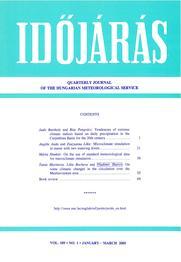IDŐJÁRÁS - angol nyelvű folyóirat
Vol. 109, No. 1 * Pages 1–69 * January - March 2005
 |
|
 letöltés [pdf: 28321 KB]
letöltés [pdf: 28321 KB]
Tendencies of extreme climate indices based on daily precipitation in the Carpathian Basin for the 20th century
Bartholy Judit, Pongrácz Rita
idojaras.2005.1.1 (p. 1–)
Bartholy Judit, Pongrácz Rita
idojaras.2005.1.1 (p. 1–)
Microclimate simulation in maize with two watering levels
Anda Angéla, Lőke Zsuzsanna
idojaras.2005.1.2 (p. 21–)
Anda Angéla, Lőke Zsuzsanna
idojaras.2005.1.2 (p. 21–)
On the use of standard meteorological data for microclimate simulation
Hunkár Márta
idojaras.2005.1.3 (p. 39–)
Hunkár Márta
idojaras.2005.1.3 (p. 39–)
On some climatic changes in the circulation over the Mediterranean area
Marinova, T., Bocheva, L., Sharov, V.
idojaras.2005.1.4 (p. 55–)
Marinova, T., Bocheva, L., Sharov, V.
idojaras.2005.1.4 (p. 55–)
IDŐJÁRÁS folyóirat

Az IDŐJÁRÁS a HungaroMet Nonprofit Zrt. negyedévenként megjelenő angol nyelvű folyóirata
Megrendelhető a journal.idojaras@met.hu címen.
A szerzőknek szánt útmutató itt olvasható.
Megrendelhető a journal.idojaras@met.hu címen.
A szerzőknek szánt útmutató itt olvasható.









